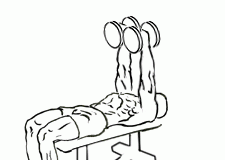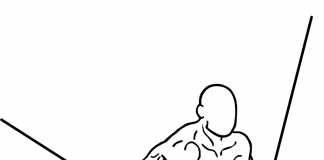Last Updated on September 29, 2014
Dumbbell squats are a fantastic way to build strength, improve balance, and enhance overall fitness. As an alternative to barbell squats, this variation is particularly beginner-friendly, allowing for greater control and less intimidation while still targeting the lower body muscles effectively. Whether you’re new to fitness or looking for a way to switch up your routine, dumbbell squats are an excellent choice.
Benefits of Dumbbell Squats
- Builds Lower Body Strength
Dumbbell squats target major muscle groups, including the quadriceps, hamstrings, glutes, and calves. Regularly practicing this exercise will help you develop strength and definition in your lower body. - Improves Core Stability
Holding dumbbells engages your core muscles to stabilize your body during the movement. This not only improves balance but also strengthens your abs and lower back. - Enhances Functional Fitness
Squatting is a natural movement pattern that mimics daily activities like sitting and standing. Performing dumbbell squats improves your functional strength, making everyday tasks easier. - Accessible for Beginners
Dumbbell squats require less technical skill than barbell squats, making them ideal for beginners. Additionally, the equipment needed—a pair of dumbbells—is widely available and easy to use.
How to Perform Dumbbell Squats Properly
Proper technique is crucial to maximize benefits and prevent injury. Follow these step-by-step instructions to master the dumbbell squat:
Step 1: Prepare Your Dumbbells and Position
- Grab a dumbbell in each hand, ensuring the weights are manageable but challenging.
- Stand with your feet slightly wider than shoulder-width apart.
- Point your toes slightly outward, aligning them with your knees.
Step 2: Engage Your Core and Maintain Proper Posture
- Tighten your core muscles by drawing your abs inward.
- Keep your chest up, shoulders back, and eyes looking forward. This posture protects your back and promotes proper alignment.
Step 3: Begin the Squat Movement
- Slowly bend your knees and hips, as if sitting back into an imaginary chair.
- Ensure your knees track over your toes without collapsing inward.
- Lower yourself until your thighs are parallel to the ground or as far as your mobility allows.
- Avoid letting your knees extend past your toes to prevent strain on your joints.
Step 4: Pause and Push Back Up
- Pause briefly at the bottom of the squat to engage your glutes and hamstrings fully.
- Press through your heels and return to the starting position in a controlled manner.
- Avoid locking your knees at the top to maintain tension in your muscles.
Pro Tip for Beginners
If you’re new to squats, start by practicing the movement without weights. This allows you to focus on form and build confidence before adding resistance.
Common Mistakes to Avoid
- Rounding Your Back
Avoid slouching or rounding your back during the squat. Maintain a straight spine throughout the movement to prevent injury. - Shifting Weight to Your Toes
Ensure your weight is evenly distributed across your feet, with an emphasis on your heels. Shifting forward can compromise your balance and strain your knees. - Using Too Much Weight Too Soon
Start with lighter weights to perfect your form. Increasing the weight prematurely can lead to improper technique and potential injury. - Not Squatting Deep Enough
While depth may vary depending on your flexibility, aim to lower your hips to at least knee level for optimal muscle engagement. - Allowing Knees to Cave Inward
Focus on pushing your knees outward as you squat to avoid unnecessary stress on your joints.
Modifications and Variations
Dumbbell squats can be adapted to suit different fitness levels and goals. Here are a few modifications and variations to try:
- Goblet Squat
Hold a single dumbbell vertically at chest level with both hands. This variation emphasizes the quads and is ideal for beginners looking to improve balance. - Sumo Dumbbell Squat
Position your feet wider than shoulder-width apart and point your toes outward. This stance targets the inner thighs and glutes more intensely. - Dumbbell Front Squat
Hold the dumbbells at shoulder level instead of by your sides. This shifts the center of gravity forward, increasing core engagement. - Single Dumbbell Squat
Use one dumbbell held at chest level with both hands. This simplifies the movement while still providing resistance. - Pulsing Dumbbell Squats
Perform small, controlled pulses at the bottom of the squat to increase time under tension and intensify the burn.
Incorporating Dumbbell Squats Into Your Routine
Dumbbell squats are versatile and can be included in various workout routines. Here’s how you can integrate them into your fitness plan:
- Strength Training Circuit
Include dumbbell squats in a lower-body circuit along with lunges, deadlifts, and calf raises. - Full-Body Workout
Pair squats with upper-body exercises like dumbbell shoulder presses or bicep curls for a balanced full-body session. - Cardio-Focused Routine
Perform dumbbell squats at a faster pace for a cardio boost while still strengthening your muscles. - Reps and Sets Recommendation
- Beginners: 3 sets of 10–12 reps with light dumbbells.
- Intermediate: 4 sets of 8–10 reps with moderate dumbbells.
- Advanced: 4–5 sets of 6–8 reps with heavier dumbbells.
Benefits for Specific Goals
For Muscle Building
Dumbbell squats are a compound exercise, meaning they work multiple muscle groups simultaneously. Incorporating heavier weights and progressive overload can help build muscle mass in the lower body.
For Weight Loss
Squats are a high-calorie-burning exercise that activates large muscle groups. Combined with a calorie deficit, dumbbell squats can aid in weight loss by boosting metabolism and improving overall fitness.
For Improved Mobility
The dynamic nature of squats improves flexibility in the hips, knees, and ankles, enhancing your range of motion and reducing the risk of injury.
FAQs About Dumbbell Squats
1. Can I perform dumbbell squats every day?
While consistency is key, rest days are essential for muscle recovery. Perform squats 2–3 times a week, depending on your fitness level and goals.
2. How heavy should my dumbbells be?
Choose a weight that challenges you while allowing proper form. Beginners can start with 5–10 lbs per dumbbell, gradually increasing as they build strength.
3. Are dumbbell squats safe for people with knee pain?
Dumbbell squats can be safe if performed correctly and with appropriate weight. However, individuals with knee pain should consult a healthcare professional before attempting squats.
4. Can dumbbell squats replace barbell squats?
Dumbbell squats are a great alternative, especially for beginners or those without access to a barbell. However, barbell squats allow for heavier loads, making them better for advanced strength training.
Final Thoughts
Dumbbell squats are a versatile and effective exercise suitable for beginners and seasoned lifters alike. By mastering proper form and gradually increasing intensity, you can achieve significant improvements in strength, stability, and overall fitness. Whether you’re working out at a home gym or in a fitness center, this simple yet powerful exercise deserves a spot in your routine.
Start practicing dumbbell squats today and take the first step toward a stronger, healthier you!






